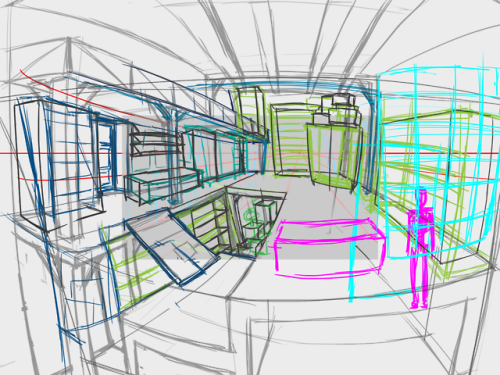

An online experiment in which we asked people to rank the perspectives in order of preference showed a clear preference for NP compared to the FP and LP. In this study, we built a real three-dimensional scene and produced photographs of the scene in three different perspectives (NP, LP and FP). In this paper, we will consider how artists have actually depicted visual space, and present evidence that images created according to a “natural” perspective (NP) used by artists are judged as better representations of visual space than those created using standard linear (LP) and curvilinear fisheye (FP) projective geometries. However, when we survey the history of European art it is evident that few artists fully complied with its mathematical rules, despite many of them being rigorously trained in its procedures. The precise perspective lines and vanishing points in combination with the variety of sizes for buildings and human figures may provide insight in the employed production method and the perceptual experience of a given scene.įollowing its discovery in fifteenth-century Italy, linear perspective has often been hailed as the most accurate method of projecting three-dimensional visual space onto a two-dimensional picture plane. Shadows are stereotypical in all and even impossible in two of the analysed paintings. Sizes of buildings and human figures deviate from the rules of linear perspective in many of the analysed paintings. The geometry of Piazza San Marco is misjudged in three paintings, questioning their authenticity. Accurate reconstruction is virtually impossible from observation alone because of the irregular quadrilateral shape of the Piazza. Analysis of nine paintings shows that Canaletto almost perfectly constructed perspective lines and vanishing points in his paintings. Canaletto is generally regarded as a great master of linear perspective. In this regard the paintings of the Piazza San Marco in Venice by Canaletto in the eighteenth century are of particular interest because of the Piazza's extraordinary geometry, and the fact that Canaletto produced a number of paintings from similar but not identical viewing positions throughout his career. Paintings of extant scenes are interesting objects for studying perspective, because such paintings provide insight into how painters apply different aspects of perspective in creating highly admired paintings.


Perspective plays an important role in the creation and appreciation of depth on paper and canvas. The implications of the findings to improving proportional accuracy in observational drawing are discussed. The reduction of the size inflation when participants are asked draw both a target and background objects is more likely a result of the selective attention to proportional relationships in the mirror scene, rather than a manifestation of an evenly scaled visual space under distributed visual spatial attention. The size of the inflation suggests a conflation of the perceived mirror image size with the size of the distal object it signals rather than a complete take-over by the latter. An account for the inflation in terms of a mechanism of size constancy contingent on selective attention is offered. The inflation also diminishes with a smaller mirror and at a longer viewing distance. Having to include in the drawing background objects visible in the mirror is found to reduce the inflation. The inflation is not confined to the image of one’s own head but is likely to occur in depictions of any object from a mirror with the mirror frame included. In three experiments, a bias to inflate in drawing the proportion of an image on a mirror over the mirror itself is demonstrated in a sample ( N = 146) of undergraduate students taking introductory psychology classes.


 0 kommentar(er)
0 kommentar(er)
